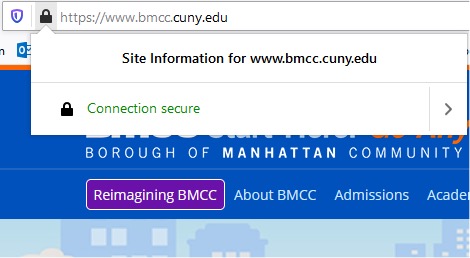Always use HTTPS for browsing
HTTPS is a way to securely communicate over a network. When browsing web sites on the internet, you will want to make sure that your connections are encrypted to protect your privacy and any sensitive information that will be transmitted.
An easy way to check if your connection is over HTTPS is to look for the padlock symbol in your browser.

Most modern browsers will also bring up a warning screen to tell you if there is something amiss with the HTTPS connection to the web site. Whether you choose to proceed despite the warning is at your own risk.
Please note that even if a website uses HTTPS, that does not necessarily mean the website is safe. It only means that the connection between your device and the web server is encrypted.
Try not to use public Wi-Fi
Wi-Fi connections over open networks tend to not be as secure as networks that require authentication.
The problems with open networks:
- Connections may not be encrypted. Anyone in the vicinity could capture the signals broadcast through the air and read the traffic you are sending.
- An attacker could set up a rogue access point. This is a device that they own that will advertise the name of a Wi-Fi network to lure unsuspecting users into connecting to it. Often these networks will have similar names to hotels, cafés, or other areas that provide open Wi-Fi services. For example, you may believe that you are connecting to a network called Starbucks-WiFi but in reality that network could be a network that anyone set up. There is no indication on whether it is owned by the café or not.
If you must use public Wi-Fi, do not log into any account that contains sensitive information unless you are also using a VPN.
BMCC provides Wi-Fi services for students, faculty, staff, and guests.
BMCC-Secured: Secure Wi-Fi to be used by students, faculty, and staff. Authenticate to the Wi-Fi using your BMCC credentials.
BMCC-Unsecured: Open network that can be used by guests and visitors. Connecting to this network will bring up a captive portal, which will send you credentials to authenticate after filling out some information.
Always “forget” the WiFi networks your device connects to
Once you connect to a network, your device will “remember” that network and try to automatically connect every time it is in range.
The problem with this behavior is that your device will only check for the name of the Wi-Fi network that it remembered.
So anyone could set up a Wi-Fi network with the same name and your device will try to connect to it. It will send any cached credentials that were used to previously authenticate to that network with that name.

